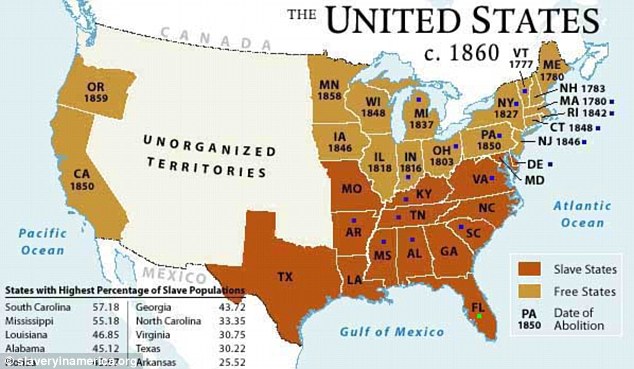Cultural and – more recently – political changes have shifted the traditional border between North and South
One way and another, surveyors have left their mark on American history. George Washington started his career as one. Then came Charles Mason and Jeremiah Dixon, two from Britain who in the 1760s used their skills to settle a boundary dispute between the then colonies of Pennsylvania and Maryland.
Whether or not the word “Dixie” derives from Jeremiah’s surname is unclear. (According to another theory, it originates with the “Dix” on the back of $10 bills in New Orleans.) But the physical line he helped to demarcate, and its later unofficial extension west along the Ohio river, came to symbolise the great divide between the North and the South, between the slave and non-slave states that fought the American Civil War.
Even now, along today’s Maryland/Pennsylvania line, you can still see some of the old mile markers of the Mason-Dixon line, great 500-pound slabs of limestone shipped from England. But no longer does this 233-mile border symbolize America’s ancestral cultural divide. That line is sliding gently but inexorably southwards, testament to a shift in US society that could play a critical role in this year’s election.
In fact, the unofficial western extension still holds good; the mighty Ohio remains a North/South frontier. If Washington D.C. fell to the Confederate armies, Abraham Lincoln reputedly said, he would set up a new capital in Ohio, which then was the third-most populous state in the Union. But head south across the river from Cincinnati and you’re in another world – or, more exactly, Kentucky. The first town you hit is Florence, or as the sign on the water tower that dominates the skyline has it, “Florence, Y’all”.
Boundaries drawn on maps are rarely cultural. Across the South there are pockets of Northernness – mostly in the cities – while Pennsylvania, although north of the Mason-Dixon line, has its share of good ol’ boys. But the South is different, and even if you can’t quite put your finger on how, when you arrive there you know it. Maryland may be many things, but Dixie it ain’t. It’s been almost 150 years since the Civil War ended, while immigration has brought millions of Hispanics and other foreign-born minorities to the region, diluting the indigenous Southern flavor. Then there’s America’s own internal globalization.
Not only have the lands south of Mason-Dixon become less Southern; those to the north are less Northern. Take the classic Dixie favorite, sweet tea, that at a certain point as you drove north was no longer available at roadside stops. Now you can get it at any McDonald’s.
But the biggest factor in the South’s geographical and cultural retreat is the physical embodiment of the federal government it took up arms against: Washington, D.C. Barely three-quarters of a century ago it was a segregated, indisputably southern city. But the Great Depression and World War II transformed it.
The federal government exploded, sucking in Northerners and prompting JFK’s quip that the capital was “a city of Southern efficiency and Northern charm”. You still come across reminders of what once was: the gracious homes of Georgetown, the soft lilt of a grizzled black cab driver – and the persisting unofficial segregation by neighborhood. But these days Washington is a Northern city, no longer even majority black.
Today the U.S. Census Bureau still lumps Maryland and D.C. in its South Atlantic region, along with Virginia, the Carolinas and Georgia. In reality, the symbolic Mason-Dixon line has slipped deep into Virginia. While Richmond, capital of the Confederacy, is still indisputably the South, northern Virginia is full of people born somewhere else.
Conservative old-timers from the real Virginia, of gun shops and Confederate flags, refer to these expanses inhabited by non-natives as “Occupied Virginia”. To find the real thing, you must travel 50-odd miles south or west of Washington to realise that, finally, you’re in the South.
In political terms, Virginia’s fate may already be sealed. The line between North and South is turning into a political chasm. The states to the north are growing more Democrat, while the south proper is a Republican redoubt.
But the moving Mason-Dixon line has now cut Virginia politically in half; a state which had voted Republican in every election for 40 years has joined Ohio and Florida among the three most hotly contested election battlegrounds. For that, blame “Occupied Virginia,” which carried Obama to victory in 2008. And if Virginia backs Obama in November, he’s virtually assured of a second term.
That may not be the end of it. Four years ago, Obama even squeaked a win in North Carolina. He probably won’t repeat the feat in 2012. But whatever happens, those old stones along the Pennsylvania/Maryland line are relics of a vanished age.
–Rupert Cornwell, The (London) Independent



